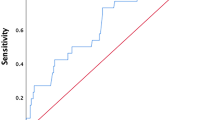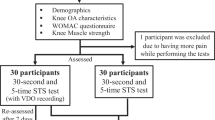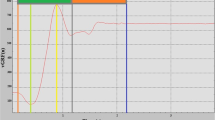Abstract
Background and aims: The five-timessit- to-stand test (FTSST) is a physical performance test commonly-used in clinical geriatric studies. The relationship between FTSST times and dynamic balance has not been widely investigated in older adults. The main objective of this study was to evaluate the validity of the FTSST as a measure of dynamic balance in older adults. A second objective was to quantify relative and absolute reliability, as well as minimum detectable change (MDC) of the FTSST in older adults. Methods: Twenty-nine females (mean age, 73.6 years) performed two trials of the FTSST, timed up and go (TUG), and functional reach (FR) tests. Validity of the FTSST as a measure of dynamic balance was evaluated by quantifying strength of relationships between the FTSST and two measures of dynamic balance, TUG and FR, using Pearson’s correlation coefficient. Measures of relative [intraclass correlation coefficient (ICC)] and absolute [standard error of measurement (SEM)] reliability, as well as the MDC at the 95% confidence level (MDC95) were computed for the FTSST. Results: The Pearson’s correlation coefficient between FTSST and TUG (r=0.64, p<0.001) indicates that FTSST is a valid measure of dynamic balance and functional mobility in older adults. The ICC2,1 of 0.95 is indicative of excellent relative reliability of the FTSST. SEM was 0.9 seconds and MDC95 was 2.5 seconds for the FTSST. SEM (6.3% of mean FTSST) and MDC (17.5% of mean FTSST) percent values were low. Conclusions: The FTSST is a valid measure of dynamic balance and functional mobility in older adults. The high ICC and low SEM and SEM% suggest excellent relative and absolute reliability and reproducibility of the FTSST in older adults. Change in FTSST performance should exceed 2.5 seconds to be considered real change beyond measurement error.
Similar content being viewed by others
References
Rubenstein LZ. Falls in older people: epidemiology, risk factors and strategies for prevention. Age Ageing 2006; 35 (Suppl 2): ii37–41.
Lord SR, Murray SM, Chapman K, Munro B, Tiedemann A. Sit-to-stand performance depends on sensation, speed, balance, and psychological status in addition to strength in older people. J Gerontol A Biol Sci Med Sci 2002; 57: M539–43.
Hughes MA, Myers BS, Schenkman ML. The role of strength in rising from a chair in the functionally impaired elderly. J Biomech 1996; 29: 1509–13.
Whitney SL, Wrisley DM, Marchetti GF, Gee MA, Redfern MS, Furman JM. Clinical measurement of sit-to-stand performance in people with balance disorders: validity of data for the Five- Times-Sit-to-Stand Test. Phys Ther 2005; 85: 1034–45.
Powell LE, Myers AM. The Activities-specific Balance Confidence (ABC) Scale. J Gerontol A Biol Sci Med Sci 1995; 50A: M28–34.
Shubert TE, Schrodt LA, Mercer VS, Busby-Whitehead J, Giuliani CA. Are scores on balance screening tests associated with mobility in older adults? J Geriatr Phys Ther 2006; 29: 33–9.
Podsiadlo D, Richardson S. The timed “Up & Go”: a test of basic functional mobility for frail elderly persons. J Am Geriatr Soc 1991; 39: 142–8.
Duncan PW, Weiner DK, Chandler J, Studenski S. Functional reach: a new clinical measure of balance. J Gerontol 1990; 45: M192–7.
Haley SM, Fragala-Pinkham MA. Interpreting change scores of tests and measures used in physical therapy. Phys Ther 2006; 86: 735–43.
Hollman JH, Beckman BA, Brandt RA, Merriwether EN, Williams RT, Nordrum JT. Minimum detectable change in gait velocity during acute rehabilitation following hip fracture. J Geriatr Phys Ther 2008; 31: 53–6.
Meretta BM, Whitney SL, Marchetti GF, Sparto PJ, Muirhead RJ. The five times sit to stand test: responsiveness to change and concurrent validity in adults undergoing vestibular rehabilitation. J Vestib Res 2006; 16: 233–43.
Shumway-Cook A, Brauer S, Woollacott M. Predicting the probability for falls in community-dwelling older adults using the Timed Up & Go Test. Phys Ther 2000; 80: 896–903.
Lin MR, Hwang HF, Hu MH, Wu HD, Wang YW, Huang FC. Psychometric comparisons of the timed up and go, one-leg stand, functional reach, and Tinetti balance measures in community-dwelling older people. J Am Geriatr Soc 2004; 52: 1343–8.
Isles RC, Choy NL, Steer M, Nitz JC. Normal values of balance tests in women aged 20–80. J Am Geriatr Soc 2004; 52: 1367–72.
Shrout PE, Fleiss JL. Intraclass correlations: uses in assessing rater reliability. Psychol Bull 1979; 86: 420–8.
Stratford PW, Goldsmith CH. Use of the standard error as a reliability index of interest: an applied example using elbow flexor strength data. Phys Ther 1997; 77: 745–50.
Stratford PW. Getting more from the literature: estimating the standard error of measurement from reliability studies. Physiotherapy Canada 2004; 56: 27–30.
Portney LG, Watkins MP. Foundations of Clinical Research: Applications to Practice, 3rd ed. Upper Saddle River, NJ: Prentice- Hall, Inc., 2009.
Bland JM, Altman DG. Statistical methods for assessing agreement between two methods of clinical measurement. Lancet 1986; 1: 307–10.
Wagner JM, Rhodes JA, Patten C. Reproducibility and minimal detectable change of three-dimensional kinematic analysis of reaching tasks in people with hemiparesis after stroke. Phys Ther 2008; 88: 652–63.
Yamada T, Demura S. Relationships between ground reaction force parameters during a sit-to-stand movement and physical activity and falling risk of the elderly and a comparison of the movement characteristics between the young and the elderly. Arch Gerontol Geriatr 2009; 48: 73–7.
Cheng PT, Liaw MY, Wong MK, Tang FT, Lee MY, Lin PS. The sit-to-stand movement in stroke patients and its correlation with falling. Arch Phys Med Rehabil 1998; 79: 1043–6.
Steffen T, Seney M. Test-retest reliability and minimal detectable change on balance and ambulation tests, the 36-item shortform health survey, and the unified Parkinson disease rating scale in people with parkinsonism. Phys Ther 2008; 88: 733–46.
Jaeschke R, Singer J, Guyatt GH. Measurement of health status. Ascertaining the minimal clinically important difference. Control Clin Trials 1989; 10: 407–15.
Copay AG, Subach BR, Glassman SD, Polly DW Jr, Schuler TC. Understanding the minimum clinically important difference: a review of concepts and methods. Spine J 2007; 7: 541–6.
Author information
Authors and Affiliations
Corresponding author
Additional information
Portions of the data in this manuscript were presented in podium format at the Combined Sections Meeting of the American Physical Therapy Association in February 2012.
Rights and permissions
About this article
Cite this article
Goldberg, A., Chavis, M., Watkins, J. et al. The five-times-sit-to-stand test: validity, reliability and detectable change in older females. Aging Clin Exp Res 24, 339–344 (2012). https://doi.org/10.1007/BF03325265
Received:
Accepted:
Published:
Issue Date:
DOI: https://doi.org/10.1007/BF03325265




